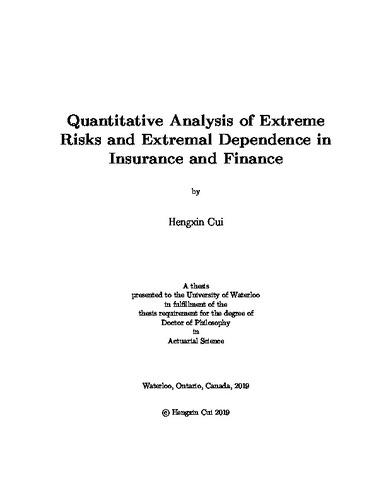| dc.contributor.author | Cui, Hengxin | |
| dc.date.accessioned | 2019-09-25 14:54:27 (GMT) | |
| dc.date.available | 2019-09-25 14:54:27 (GMT) | |
| dc.date.issued | 2019-09-25 | |
| dc.date.submitted | 2019-09-23 | |
| dc.identifier.uri | http://hdl.handle.net/10012/15151 | |
| dc.description.abstract | In this thesis, we aim at a quantitative understanding of extreme risks and extremal depen- dence in insurance and finance. We use regularly varying distribution functions in extreme value theory (EVT) to model extreme risks, and apply various tools in multivariate extreme value theory (MEVT) to capture extremal dependence. We focus on developing asymptotics for certain risk measures.
We start with a portfolio diversification problem. In finance, investors usually construct a mixed portfolio in order to diversify away the individual risks. However, this is not always the case when heavy-tailedness and tail dependence of large losses are considered. Chapter 3 applies the multivariate regular variation (MRV) model to study this problem in an asymptotic sense and provides an applicable portfolio optimization strategy. A practical performance test for our strategy is also provided in this Chapter.
The mainstream of the literature on the limitation of portfolio diversification follows the assumption that risks have unbounded distribution support, i.e., no cap for potential loss. However, real-world firms usually have limited liability. Then a natural question arises whether the non-diversification effect strictly depends on the tail behaviour of the loss distribution. For risks with bounded support, will similar non-diversification results still exist? We answer this question in Chapter 4 and we argue that diversification is still possible to be inferior as long as the risks are truncated at sufficiently large threshold level.
In Chapter 5, we consider the risk of a large credit portfolio of multiple obligors subject to possible default. Contrary to the Gaussian and t copulas that are widely used in practice, we assume a portfolio dependence structure of Archimedean copula type. Under this setting, we derive sharp asymptotics for portfolio credit risk that highlight the impact of extremal dependence among obligors. By utilizing these asymptotic results, we propose two different algorithms that are shown to be asymptotically optimal and can be applied to efficiently estimate portfolio credit risk via Monte Carlo simulation. In order to capture hierarchical dependence structure among the obligors in a large credit portfolio, we also extend our asymptotic analysis to the structure of nested Gumbel copulas and an efficient algorithm of bounded relative error is also developed for this more complex structure. Numerical results are provided at the end of the chapter to illustrate the performance of our algorithms, as well as their respective merits. | en |
| dc.language.iso | en | en |
| dc.publisher | University of Waterloo | en |
| dc.subject | quantitative analysis | en |
| dc.subject | extreme value theory | en |
| dc.subject | portfolio diversification | en |
| dc.subject | rare event simulation | en |
| dc.title | Quantitative Analysis of Extreme Risks and Extremal Dependence in Insurance and Finance | en |
| dc.type | Doctoral Thesis | en |
| dc.pending | false | |
| uws-etd.degree.department | Statistics and Actuarial Science | en |
| uws-etd.degree.discipline | Actuarial Science | en |
| uws-etd.degree.grantor | University of Waterloo | en |
| uws-etd.degree | Doctor of Philosophy | en |
| uws.contributor.advisor | Tan, Ken Seng | |
| uws.contributor.advisor | Yang, Fan | |
| uws.contributor.affiliation1 | Faculty of Mathematics | en |
| uws.published.city | Waterloo | en |
| uws.published.country | Canada | en |
| uws.published.province | Ontario | en |
| uws.typeOfResource | Text | en |
| uws.peerReviewStatus | Unreviewed | en |
| uws.scholarLevel | Graduate | en |

